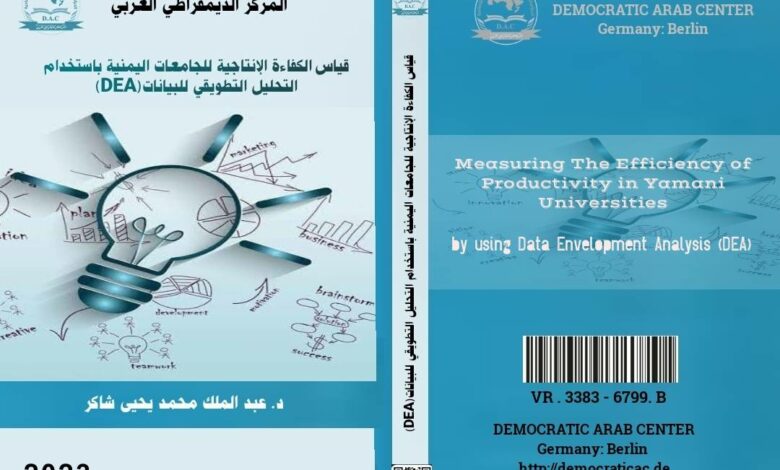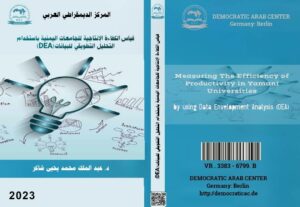قياس الكفاءة الإنتاجية للجامعات اليمنية باستخدام التحليل التطويقي للبيانات – DEA –
Measuring The Efficiency of Productivity in Yamani Universities by using Data Envelopment Analysis (DEA)

تأليف : د. عبد الملك محمد يحيى شاكر – استاذ الادارة والتخطيط التربوية المساعد، كلية التربية -جامعة صعدة – الجمهورية اليمنية
نسخة “pdf”-
قياس الكفاءة الإنتاجية للجامعات اليمنية باستخدام التحليل التطويقي للبيانات – DEA –
الطبعة الأولى “2023″ –من كتاب: قياس الكفاءة الإنتاجية للجامعات اليمنية باستخدام التحليل التطويقي للبيانات – DEA
جميع حقوق الطبع محفوظة #المركز_الديمقراطي_العربي ولا يسمح بإعادة إصدار هذا الكتاب أو اي جزء منه أو تخزينه في نطاق إستعادة المعلومات أو نقله بأي شكل من الأشكال، دون إذن مسبق خطي من الناشر .
تقديم :
يهدف هذا الكتاب إلى بيان وتوضيح طرق وأساليب قياس الكفاءة الإنتاجية الداخلية (الحجمية، والفنية) للجامعات الحكومية اليمنية باستخدام أسلوب التحليل التطويقي للبيانات ((DEAوتصنيفها أو ترتيبها حسب كفاءتها الإنتاجية الداخلية المحققة، وتحديد القيم أو النسب التي يمكن خفضها من مدخلات الجامعات غير الكفؤة ـ وأيضاً ـ التي يمكن زيادتها في مخرجات تلك الجامعات حتى تحقق الكفاءة الإنتاجية ، وأخيراً تحديد الجامعات المرجعية ـ لكل جامعة غير كفؤة والتي استطاعت تحقيق الكفاءة الإنتاجية الداخلية على الرغم من أنها تعمل في نفس الظروف التنافسية للجامعات غير الكفؤة.
ويتضمن هذا الكتاب أربعة فصول، يتناول الفصل الأول: الاطار العام والدراسات السابقة ومناقشتها، ويتناول الفصل الثاني: الاطار النظري المتعلق بالموضوع، وذلك وفق مبحثين: المبحث الأول يتناول قـياس الكفاءة الإنتاجية الجامعية وسبل تعزيزها، ويعرض المبحث الثاني: أهم الطرائق و الأساليب الكمية الحديثة في قياس الكفاءة الإنتاجيةالجامعية، أما الفصل الثالث : فقد خصص لعرض واقع الجامعات الحكومية اليمنية من منظور كمي، ويتناول الفصل الرابع: الإجراءات الـتطـبيقيـةوعرض النتائج ومناقشتها، وذلك وفق مبحثين: يوضح المبحث الأول الإجراءات المتبعةلقياس الكفاءة الإنتاجية الداخلية (الحجمية، والفنية) للجامعات الحكومية اليمنية باستخدام أسلوب التحليل التطويقي للبيانات(DEA)، مطبقاً نموذج عوائد الحجم الثابتة ((CRS، ونموذج عوائد الحجم المتغيرة(VRS)بالتوجهين الإدخاليوالإخراجي، و قد شملت المتغيرات تصنيفين؛ تضمن التصنيف الأول أربعة متغيرات هي (إجمالي عدد الطلبة الخريجين)من جانب المخرجات، ومن جانب المدخلات كانت: (إجمالي أعضاء هيئة التدريس، عدد الكليات والأقسام، إجمالي عدد الطلبة الملتحقين بالجامعة)، وذلك لحساب الكفاءة الإنتاجية الداخلية الحجمية، بينما تضمن التصنيف الثاني خمسة متغيرات هي: (معدل النجاح بجميع المستويات، عدد الساعات التدريسية الأسبوعية لأعضاء هيئة التدريس ( من جانب المخرجات، ومن جانب المدخلات كان: (معدل طالب/ عضو هيئة تدريس بدرجة دكتوراه، عدد الطلبة المتبقين بجميع المستويات، نسبة الإنفاق على الجامعة من إجمالي الإنفاق على التعليم من موازنة الدولة)، وذلك لحساب الكفاءة الإنتاجية الداخلية الفنية.
أما المبحث الثاني فيعرض النتائج ومناقشتها،والتي كان من أبرزها : أن عدد الجامعات التي حققت الكفاءة الإنتاجية الداخلية الحجمية ثلاث جامعات هي: (جامعة صنعاء، جامعة عمران، جامعة حجة) من أصل عشر جامعات محل البحث، في حين وجُـد إن عدد الجامعات الحكومية اليمنية التي حققت الكفاءة الإنتاجية الداخلية الفنية أربع جامعات هي: (جامعة عدن، جامعة ذمار، جامعة حضرموت، جامعة البيضاء )من جانبي المدخلات والمخرجات، وتمثل نسبة (40%)من إجمالي الجامعات محل البحث. وبلغ متوسط الكفاءة الإنتاجية الداخلية الفنية للجامعات الحكومية اليمنية ككل للعام الجامعي 2013/2014م (إذا كان الهدف هو خفض المدخلات) نسبة(79.4%)، وهذايعني أنه يجب عليها أن تخفض من مدخلاتها بنسبة%20.6))مع الحصول على القدر الحالي في المخرجات حتى تكون كفؤة. في حين بلغ متوسط الكفاءة الإنتاجية الداخلية الفنيةللجامعات الحكومية اليمنية ككل للعام نفسه(إذا كان الهدف هو تعظيم المخرجات) نسبة(90.3%)، وهذا يعني أنه يجب عليها لكي تحقق الكفاءة الإنتاجية الداخلية الفنية باستخدام المستوى نفسه من المدخلات أو أقل عليها أن تزيد من مخرجاتها بنسبة (9.7 %).
وفي ضوء النتائج قدم الباحث عدداً من التوصيات والمقترحات، منها:ضرورة توفير قاعدة بيانات حديثة في الجامعة اليمنية، تكون بمتناول الباحثين والمهتمين، والاستفادة من مؤشرات الكفاءة الإنتاجية الداخلية (الحجمية، والفنية) ومستويات التحسين المطلوبة من الجامعات الحكومية اليمنيةالتي لم تحقق مؤشر كفاءة إنتاجية تامة في كل من المدخلات والمخرجات وفق عوائد الحجم الثابتة،وعوائد الحجم المتغيرة .
Abdalmilk Mohammed Yahya Shaker – Educational administration and planning – Faculty of Education – SA,ADAH University-Republic of Yemen
Abstract
This book aims to demonstrate and clarify the methods and methods for measuring the internal productive efficiency (volume and technical) of Yemeni public universities using the DEA method, classifying or arranging them according to their achieved internal productive efficiency, and determining the values or percentages that can be reduced from the inputs of inefficient universities. And also – which can be increased in the outputs of those universities in order to achieve productive efficiency, and finally identify the reference universities – for each inefficient university that has been able to achieve internal productive efficiency even though it operates in the same competitive conditions as inefficient universities.This book includes four chapters, the first chapter deals with: the general framework and previous studies and their discussion, and the second chapter deals with: the theoretical framework related to the subject, according to two sections: the first topic deals with measuring university productive efficiency and ways to enhance it, and the second topic presents: the most important methods and modern quantitative methods in Measuring university productivity efficiency. As for the third chapter, it was devoted to presenting the reality of Yemeni public universities from a quantitative perspective.The fourth chapter deals with applied procedures, presenting and discussing the results, according to two sections: The first section explains the procedures used to measure the internal productive efficiency (volume and technical) of Yemeni public universities using the data empirical analysis (DEA) method, applying the constant returns to scale model (CRS) and the model Variable returns to scale (VRS) in both the input and output directions,The variables included two classifications; The first classification included four variables (total number of graduate students) on the output side, and on the input side it was: (total faculty members, number of faculties and departments, total number of students enrolled in the university), to calculate the volumetric internal productive efficiency, while the second classification included five The variables are: (success rate at all levels, number of weekly teaching hours for faculty members (from the outputs side),As for the inputs, it was: (PhD student/faculty member rate, the number of remaining students at all levels, the percentage of spending on the university out of the total spending on education from the state budget), in order to calculate the technical internal productive efficiency.As for the second topic, it presents and discusses the results, the most prominent of which was: that the number of universities that achieved volumetric internal productivity efficiency is three: (Sana’a University, Amran University, Hajjah University) out of ten universities in question, while it was found that the number of Yemeni public universities Four universities achieved the internal technical productivity efficiency: (Aden University, Dhamar University, Hadramout University, Al-Bayda University) on both sides of the inputs and outputs, and they represent (40%) of the total universities in question.The average internal technical productivity efficiency of Yemeni public universities as a whole for the academic year 2013/2014 AD (if the goal is to reduce inputs) was (79.4%), and this means that they must reduce their inputs by 20.6%)) while obtaining the current amount in outputs to be efficient. While the average technical internal productive efficiency of Yemeni public universities as a whole for the same year (if the goal is to maximize output) was (90.3%), and this means that in order to achieve the technical internal productive efficiency by using the same level of inputs or less, they must increase their its outputs by (9.7%).In the light of the results, the researcher made a number of recommendations and proposals, including: the need to provide a modern database in the Yemeni university, to be accessible to researchers and those interested, and to benefit from indicators of internal productive efficiency (volumetric and technical) and the levels of improvement required from Yemeni public universities that did not achieve an index of productive efficiency. Complete in both inputs and outputs according to fixed returns to scale and variable returns to scale.
الناشر: المركـز الديمقراطي العربي للدراسات الاستراتيجية والسياسية والاقتصادية – ألمانيا – برلين
Democratic Arabic Center- Berlin – Germany






تعليق واحد